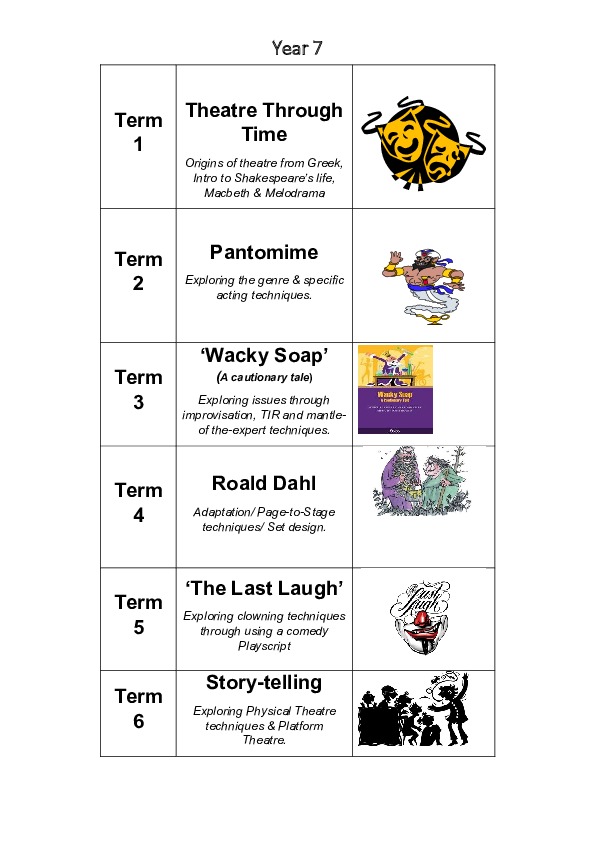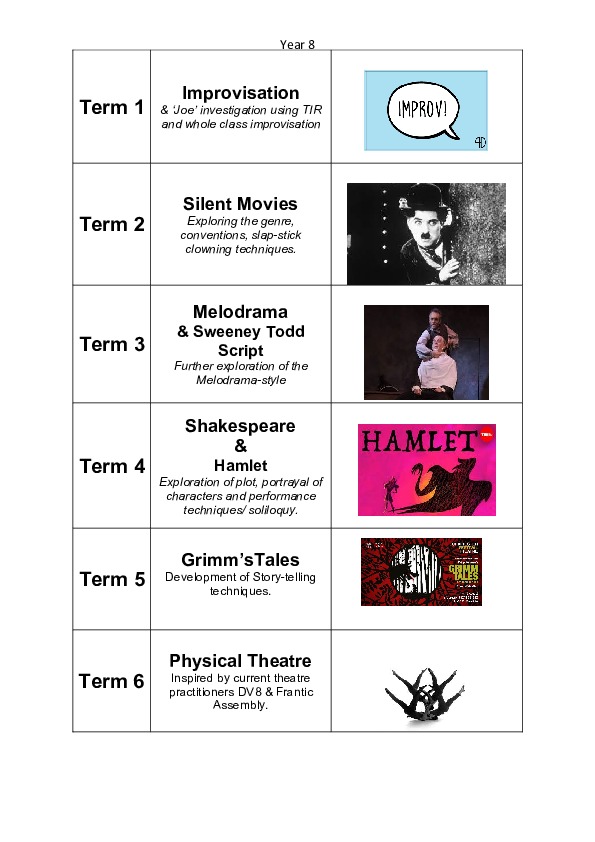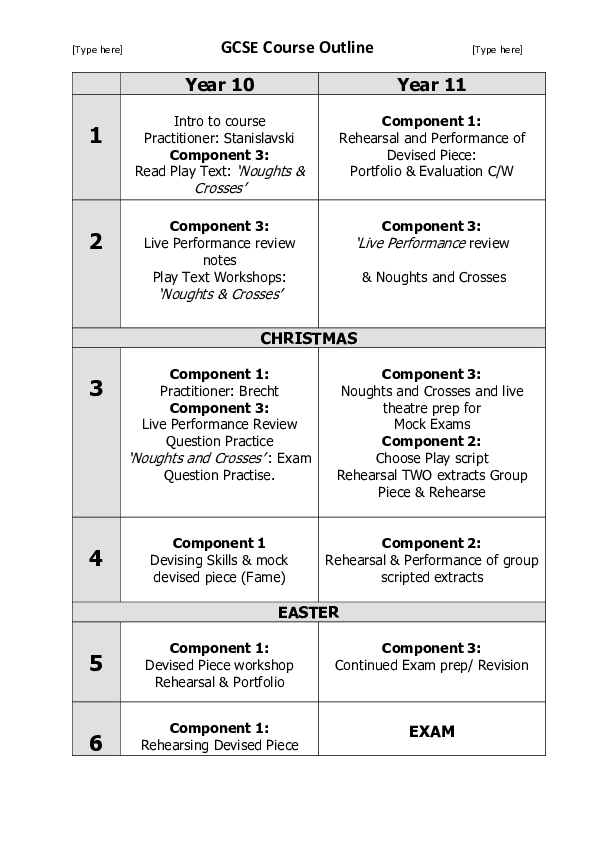Drama
BackThe Drama department offer a variety of extracurricular activities in addition to the curriculum. For what we offer, please see the timetable below:
Learning Journeys




Curriculum Overview
| Year 7 | Term 1 | Term 2 | Term 3 |
|---|---|---|---|
| Key Topic: |
Theatre Through Time Pantomime |
‘Wacky Soap’ allegory
Roald Dahl Adaptations |
'The Last Laugh’ by Ben Payne Play text
Storytelling |
| New Knowledge: |
|
|
|
| Previous Knowledge Required: |
In KS2, the national curriculum states that children should prepare poems and play scripts to read aloud and to perform, showing understanding through intonation, tone, volume and action so that the meaning is clear to an audience. Therefore, a basic understanding of performance skills to a live audience is required. Knowledge of basic performance skills and techniques gained during ‘Theatre Through Time’. |
Knowledge of team work, collaborative, negotiation skills to create and progress drama work. Knowledge of over-exaggerated Characterisation skills gained in Pantomime. Build on use of Still Images/Tableaux and Narration |
Knowledge of Character Performance skills.
Basic conventions of a script. Knowledge of improvising and creating characters and storylines building on all the skills learnt so far this year. Teamwork and collaboration.
|
| New Skills: |
Teamwork and social skills negotiation and compromise. Tableaux/ Still Images, Chorus and Narration Skills. Pantomime acting skills – stereotypical characterisations and over-exaggerated gestures, facial expressions and actions. Audience Interaction and Direct Address. |
Develop skills of Spontaneous Role-Play Self-evaluation and peer-evaluation skills. Take on the role of an expert and debate their point-of-view. To create and perform in the genre of an advert and a News report. To be able to communicate meaning and messages using drama To be able to adopt different status’s for different characters Develop and expand characterisation skills by using rehearsal techniques ‘Hot-Seating’ and Thought-Tracking How to adapt a novel for stage performance. Develop use of Narration and Tableaux/still Images |
Ability to read and interpret a script in a comedic way utilising the performance skills of comedy such as ‘Deadpan’. Ability to engage with and adapt to an audience and their reactions. Development of interpreting script and characters for performance. Ability to use the techniques of using Nano-fictions, Props and other stimulus as a springboard for creating and devising a drama piece. Ability to work as a collaborative team and ensemble to create and perform a piece of original drama |
| Links to the School Curriculum | History |
English PSHE
|
English PSHE |
| Independent Activities: | Watch a Shakespeare Play either live or online: Macbeth or A Midsummer Night’s Dream – A trip to the RSC.
Watch a Pantomime either live at a local theatre or online. |
Watch Newsround and see how News reports on issues are done.
Read Roald Dahl Stories, Fantastic Mr Fox, The Twits and Matilda. Watch any live show that has been adapted from a novel eg: Matilda. |
Watch a comedy play live at a theatre or attend a live circus or comedy event.
Watch a local live theatre event at a festival or Library. |
| Web Links: |
Greek Theatre: https://www.bbc.co.uk/bitesize/topics/z87tn39/articles/zgpdjxsElizabethan Theatre: https://www.bbc.co.uk/bitesize/guides/zpscng8/revision/3Pantomime |
The Twits: https://www.youtube.com/watch?v=rirrHqSS4B8Matilda: https://www.youtube.com/watch?v=NjCosN40u94
|
Comedy acting: https://www.bbc.co.uk/bitesize/guides/zpfk6sg/revision/10Devising Drama: |
| Year 8 | Term 1 | Term 2 | Term 3 |
|---|---|---|---|
| Key Topic: |
Jo. Improvisation & Silent Movies |
Melodrama Hamlet |
Grimm Tales Physical Theatre |
| New Knowledge: |
Working with both spontaneous and rehearsed improvisation. To know how to create a character, use physical and vocal skills, perform a range of ages and characters Knowledge of the style and conventions of silent movie acting. |
Cultural History of British Theatre. Melodrama texts. Social and cultural context of Melodrama. How Actors use audience interaction.Plot, Character and themes of Hamlet. The use of Shakespearean language. Knowledge of the theatre conventions and culture of Elizabethan theatre. |
The plot characters and themes of The Grimm Tales. The use of multi-rolling. The art of storytelling. The use of self-narration within Drama.
How to create Chair duets. Techniques of ‘Frantic assembly’ theatre company. The use of physicality and movement within Drama. Cultural context of physical theatre. Communication of meaning through movement. |
| Previous Knowledge Required: |
Experience of team work, collaborative, negotiation skills to create and progress drama work. To have experience of improvisation. Team work Improvisation. Class performance examples. |
Ensemble work. Improvisation. Exaggeration. How to improvise. Working with script Use of gesture and physicality to create a character. |
Storytelling. The use of gesture. The use of physicality The application of facial expressions. The use of exaggeration. The use of facial expressions to create character and show emotions. The application of team and ensemble work.
|
| New Skills: |
Teacher in Role. Hot seating. Characterisation. Status. Mime. The use of facial expressions. Exaggeration. Clocking the audience. |
Creating stock characters. Use of asides in performance. Use of gestures to communicate meaning. Adopting script for performance. Use of proxemics. Use of Soliloquy. Use of Direct audience address. The process of character creation. |
Multi-rolling. Development of vocal skills to create character. The application of spatial relationships. The construction of narrative for storytelling. The use of physicality to create performance The use of movement as a form of storytelling The application of choreographic skills to create character and plot |
| Links to the School Curriculum |
PSHE History |
History of Victorian England History of Elizabethan England English Literature
|
English Literature Dance PE |
| Independent Activities: |
Script writing Creating a detective sheet Creative writing – Creating a background profile for the character of Jo Script writing Evaluation sheets Viewing silent movies |
Researching Theatre in nineteenth century Britain Script reading – ‘The Damsel in Distress’ Evaluation sheets Reading keys scenes from Hamlet |
Reading extracts of ‘The Grimm Tales’ Watching Physical Theatre videos |
| Web Links: |
Improvisation: https://www.youtube.com/watch?v=HZViQVCTIjI https://www.city-academy.com/news/what-is-improvisation-acting/ |
| Year 9 | Term 1 | Term 2 | Term 3 |
|---|---|---|---|
| Key Topic: |
The Robbery 'The Woman in Black'/ Ghost Stories |
'DNA' - Dennis Kelly Theatre-in-Education (TIE) |
'The Arrival' - Shaun Tan: Immigration 'The Last Resort' Comedy by Chris Owen |
| New Knowledge: |
How to create characters profiles, role on the wall to create original characters in relation to the theme of a ‘Heist’ and Robbery Gangs. Develop engaging and suspenseful plots. Knowledge of what an exposition is. To know the plot and characters of ‘The Woman In Black’ A Ghost story. How to use Narration and Flashback to create atmosphere and suspense. To know what ‘Cliff-Hanger’ and ‘Plot Twist’ means. To know what a ‘stimulus’ is in drama. |
To know the plot, characters and themes of the modern Play ‘DNA’ by Dennis Kelly To know what a duologue is. To know how to use proxemics to show character status and relationships in performance. To know what Theatre in Education is and the role of T.I.E in education. To become familiar with two Theatre in Education scripts by Mark Wheeler: ‘Too Much Punch For Judy’ and ‘Missing Dan Nolan’ and their specific real-life messages. To know that the communication of a message is a role for drama Introduction of the Theatre practitioner Bertolt Brecht and his performance techniques. |
To know what Immigration, migrant and refugee means. To understand that stories can be told through pictures/ storyboards and used as a stimulus for devising drama. To understand that world-wide issues can be highlighted through drama. To know some of the characters and situations of some of the groups of characters in this comedy play text. To know how to interpret a script and character to create humour. To know how to multi-role effectively and provide contrasts to create humour. To know what ‘blocking’ means and how to rehearse and interpret a comedy script effectively. |
| Previous Knowledge Required: |
Creation of roles and devising drama. Experience of team work, collaborative, negotiation skills to create and progress drama work. Performance techniques used in drama to create mystery and suspense both with creating roles and storytelling: Narration, Direct Address, soliloquy, Freeze-Frames. |
Hot seating, Flashbacks, Direct address, Ensemble work, Script reading and stage direction interpretations. Storytelling with Moral/messages Use of all the drama techniques learnt so far which utilise Interaction and communication with audience. |
Storytelling techniques Writing in role.
Group collaboration and creative devising skills. Script work. Comedy acting techniques. Interaction and reactions with audience. Direct address Physicality of characters.
|
| New Skills: |
Developing plot (including exposition) and complex characters in order to create a tension-filled Drama. How to create tension and suspense through use of Descriptive Narration, Freezes and Flashbacks. How to utilise a cliff-hanger and plot twist to create suspense, atmosphere and tension. |
To perform a naturalistic script interpreting character relationships through performance skills focusing on proxemics, levels and emotions and interactions of characters. To know how to create and perform a hard-hitting piece of drama based on real life facts with an important message and a moral which teaches an audience in an engaging way. |
How to sensitively create a piece of drama to highlight a world-wide issue. How to multi-role successfully and transition between scenes and character changes on stage. To create the environment/ world of the play on stage. To know how to rehearse and block scene collaboratively to create humour. |
| Links to the School Curriculum |
PSHE English Local History |
PSHE English Sociology
|
Sociology PSHE Ethics English |
| Independent Activities: |
Research real life Heist/Robbery gang stories. Research Local Ghost stories for inspiration Watch ‘The Woman In Black play live at the theatre. |
Read the play ‘DNA’ by Dennis Kelly Watch a live local Theatre-In-Education drama piece or find one to watch online. |
Watch ‘The Arrival’ by Shaun Tan picture book in the link below. Watch a comedy play either live or online. |
| Web Links: |
Hatton Heist Robbery: https://www.youtube.com/watch?v=B63v-mNpaNwThe Woman In Black: |
DNA Introduction: https://www.youtube.com/watch?v=5KwujlgvJjwTheatre in Education: |
'The Arrival' by Shaun Tan: |
|
Year 10 |
Term 1 | Term 2 | Term 3 |
|---|---|---|---|
| Key Topic: |
Component 3: Noughts & Crosses Set Text & Stanislavski |
Component 2: Live Performance Review |
Component 1: Devised Introduction & Brecht |
| New Knowledge: |
|
|
|
| Previous Knowledge Required: |
Reading and understanding a basic script for performance. Ability to read a character part and act the part practically and physically in a basic interpretation of the scene. To collaborate and work as a team for the drama. |
Knowledge of the skills and techniques of performance practitioners such as Stanislavski. How characters are created Certain drama and acting techniques such as narration and freeze frames |
Previous knowledge and understanding of devising through the key stage three process. How to create characters. How to work with others as part of a creative team.
|
| New Skills: |
|
|
|
| Links to the School Curriculum |
PSHE English
|
PSHE English History
|
PE History English |
| Independent Activities: |
Watch a live production of the play ‘Noughts and Crosses’ by Dominic Cooke |
Live Performance Review essays |
Line learning Researching performance material |
| Web Links: |
https://www.youtube.com/watch?v=B63v-mNpaNwStanislavski Explained: |
| Year 11 | Term 1 | Term 2 | Term 3 |
|---|---|---|---|
| Key Topic: | Component 1 Devised Performance & Portfolio |
Component 2 – Text in Performance |
Component 3 Written Exam Preparation |
| New Knowledge: |
|
|
|
| Previous Knowledge Required: |
|
|
|
| New Skills: |
To perform characters or present a design element to a live audience and under examination conditions. How to cope with performance pressure to perform a piece of drama under examination conditions. |
To be able to read and interpret a curriculum set text To be able to interpret characters To be able to analyse stage directions To apply rehearsal techniques in the exploration of character To identify morals, meaning and messages of play texts To explore the purpose of proxemics in defining character relationships on stage. |
Drama Revision skills Examination skills: timing, reading the questions, planning answers. |
| Links to the School Curriculum |
Music Technology |
PSHE English
|
English |
| Independent Activities: |
Watch previous devised GCSE performances online or ask your drama teacher to show last year’s cohort. |
From page to stage - Homework and essays exploring how to lift play scripts of the page to become a performance piece. |
Practise exam papers and look at marking schemes. These can be found on line in the Eduqas drama GCSE website page, below: |
| Web Links: |

